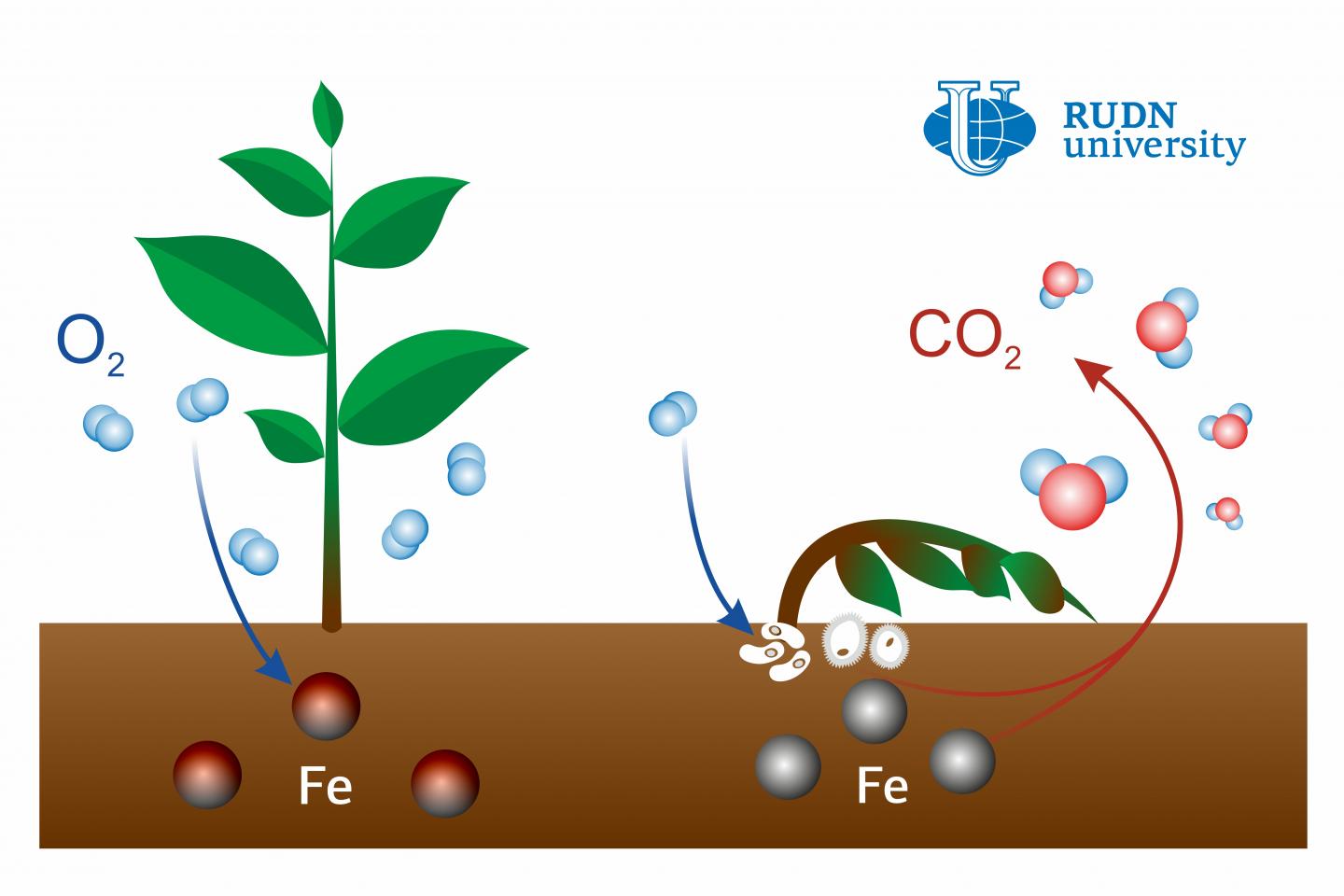
Credit: RUDN University
Iron minerals and bacteria can be the main agents of carbon dioxide emissions from the soil. A soil scientist from RUDN University made this conclusion after studying the process of organic plant waste decomposition of the micro-level. Iron and hydrogen peroxide enter into a reaction, as a result of which active oxygen forms (oxygen radicals) are formed. The radicals destroy plant waste in the soil and promote carbon dioxide emissions. The results of the study were published in the Geoderma journal.
Carbon dioxide is considered one of the main reasons for global warming, and almost half of it is released to the atmosphere from the soil. The most active ‘soil breathing’ areas usually contain decomposing plant waste. Such areas tend to have hotspots: local zones up to 1 cm3 in volume where the decomposition process is almost 100 times faster. Due to a combination of high moisture and good aeration, these hotspots offer perfect living conditions to soil microorganisms. Previously, microbial activity had been considered the reason for active CO2 emissions. However, a soil scientist from RUDN University confirmed that it was in fact oxidation-reduction transitions of soil iron that caused them.
“Previously we used to believe that the reason for carbon dioxide emissions from hotspots were microorganisms that treated plant waste with special enzymes and turned it into gas. However, we demonstrated that a big part of this process was due not only to enzymes. Iron facilitates the formation of active oxygen forms (radicals) that affect insoluble organic matter, destroy it, and turn it into the soluble state,” said Yakov Kuzyakov, a PhD in Biology, and the Head of the Center for Mathematical Modeling and Design of Sustainable Ecosystems at RUDN University.
The scientist also pointed out that microorganisms accelerate plant waste decomposition only several times, not hundreds of times. In the course of their activity bacteria release hydrogen peroxide that can react with iron and take one electron from it, creating active oxygen forms, i.e. substances with one free unpaired electron. This type of oxygen is chemically active and quickly oxidizes organic matter, causing its destruction.
To confirm that active oxygen forms cause CO2 emissions, the team created an artificial hotspot. To do so, they put 300 g of soil in a container, added plant waste (straw), and a solution of iron sulfate. The moisture level in the container was kept at 90%. The team measured the volume of CO2 emitted from the container for 40 days and then compared the results to measurement data collected from soils without iron and straw, and with low (45%) moisture levels. The sample in the container turned out to release 22 mg of CO2 per 1 kg of soil, which was approximately 22 times more than the volume released by low-moisture soil and soil without plant waste. After that, the team measured the changes in the volume of iron, carbon, hydrogen peroxide, and active oxygen forms in the vicinity of the hotspot. Based on the ratio of all these substances the team concluded that iron reacted with hydrogen peroxide and produced active oxygen.
“Unlike earlier theories, ours is focused on the primary role of active oxygen forms. It is a simple scenario. At first, plant waste stimulates the growth of bacteria. When there are enough bacteria, they consume almost all oxygen. These are perfect conditions for the concentration of iron which otherwise would oxidize. Then the iron reacts with hydrogen peroxide, and organic matter is decomposed under the influence of active oxygen forms. In its decomposed state it attracts even more bacteria, and the process intensifies several times,” added Yakov Kuzyakov.
The study was the first one to confirm that biological processes in soil hotspots are driven by the activity of free radicals (i.e. substances with a free electron). According to the team, this mechanism might also take place in other hotspots, for example, those found in the rhizosphere (the soil around plant roots). In the future, this data can be used to reduce CO2 emissions from the soil.
An iron-dependent burst of hydroxyl radicals stimulates straw decomposition and CO2 emission from soil hotspots: Consequences of Fenton or Fenton-like reactions,
###
Media Contact
Valeriya Antonova
[email protected]
Related Journal Article
http://dx.





